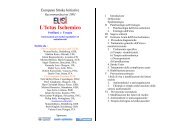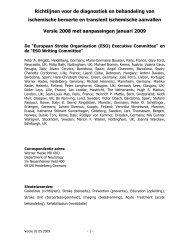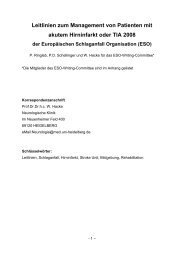Guidelines for Management of Ischaemic Stroke 2008 - ESO
Guidelines for Management of Ischaemic Stroke 2008 - ESO
Guidelines for Management of Ischaemic Stroke 2008 - ESO
Create successful ePaper yourself
Turn your PDF publications into a flip-book with our unique Google optimized e-Paper software.
<strong>ESO</strong>-<strong>Guidelines</strong> <strong>for</strong> <strong>Management</strong> <strong>of</strong> <strong>Ischaemic</strong> <strong>Stroke</strong> <strong>2008</strong><br />
Statin withdrawal at the acute stage <strong>of</strong> stroke may be associated with an increased<br />
risk <strong>of</strong> death or dependency [294].<br />
Cigarette smoking<br />
There are no specific data in secondary prevention. See primary prevention.<br />
Diet<br />
Overweight<br />
There are no specific data in secondary prevention. See primary prevention. Weight<br />
loss may be beneficial after stroke as it lowers blood pressure [245].<br />
Vitamins<br />
Beta carotene increased the risk <strong>of</strong> cardiovascular death in a meta-analysis <strong>of</strong><br />
primary and secondary prevention trials (RR 1.10; 95% CI 1.03-1.17) [295]. Vitamin<br />
E supplementation does not prevent vascular events [296]. Fat soluble antioxidant<br />
supplements may increase mortality [297].<br />
Vitamins which lower homocysteine (folate, B12, B6) do not appear to reduce stroke<br />
recurrence and may increase vascular events [298-301], but further trials are ongoing<br />
[302].<br />
Sleep-disordered breathing<br />
Sleep-disordered breathing represents both a risk factor and a consequence <strong>of</strong><br />
stroke and is linked with poorer long-term outcome and increased long-term stroke<br />
mortality [303]. More than 50% <strong>of</strong> stroke patients have sleep-disordered breathing,<br />
mostly in the <strong>for</strong>m <strong>of</strong> obstructive sleep apnoea (OSA). This can improve<br />
spontaneously after stroke, but may need treatment. Continuous positive airway<br />
pressure is the treatment <strong>of</strong> choice <strong>for</strong> OSA. Oxygen and other <strong>for</strong>ms <strong>of</strong> ventilation<br />
may be helpful in other (e.g. central) <strong>for</strong>ms <strong>of</strong> SDB.<br />
Patent <strong>for</strong>amen ovale<br />
Case reports and case control studies indicate an association between the presence<br />
- 40 -





